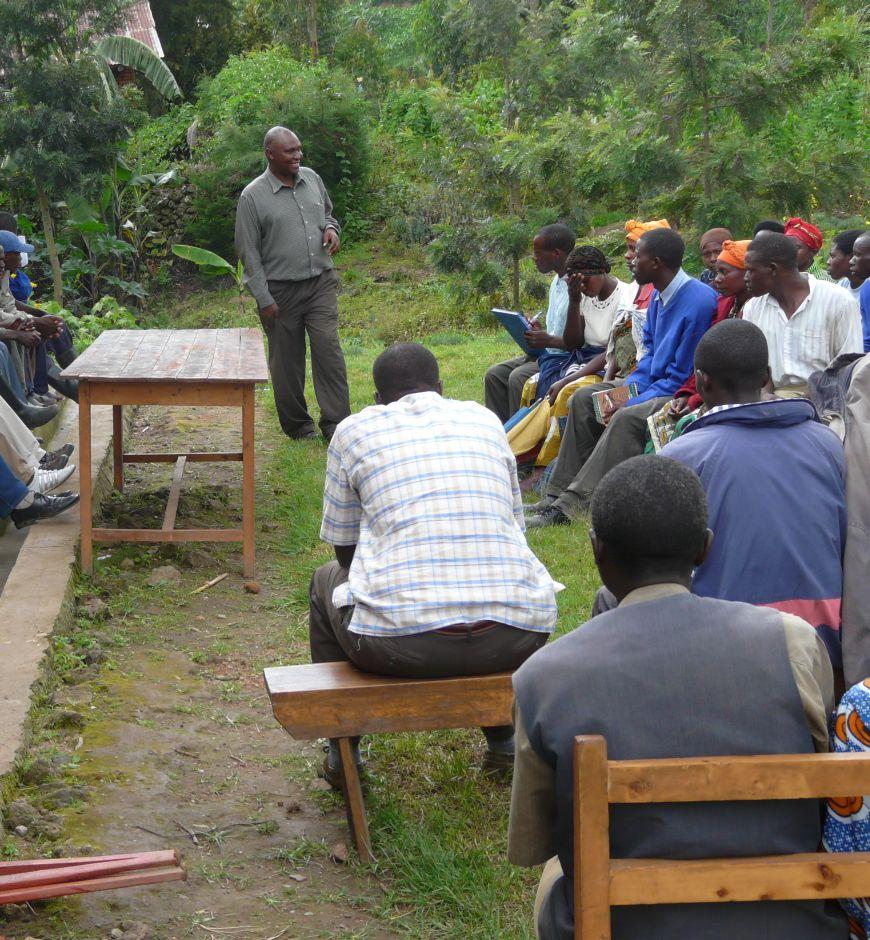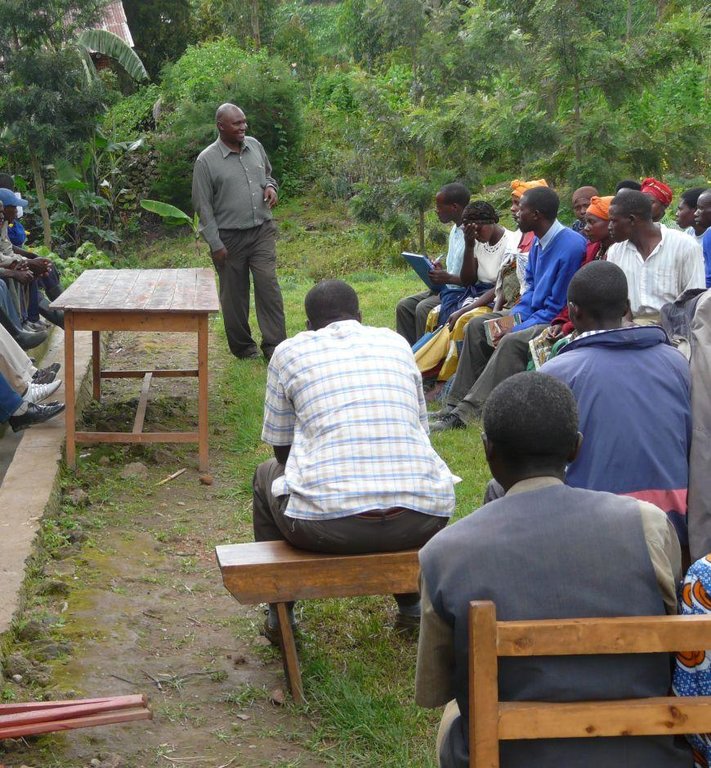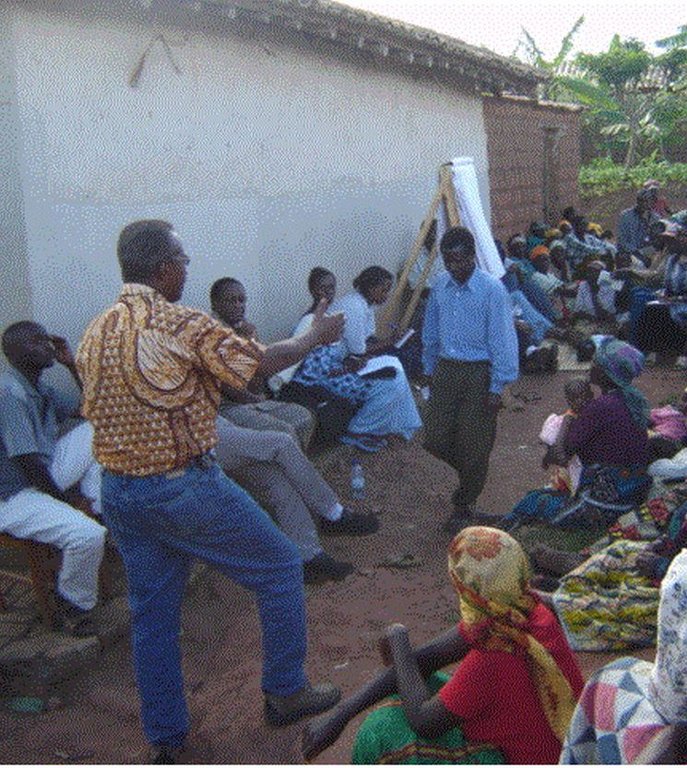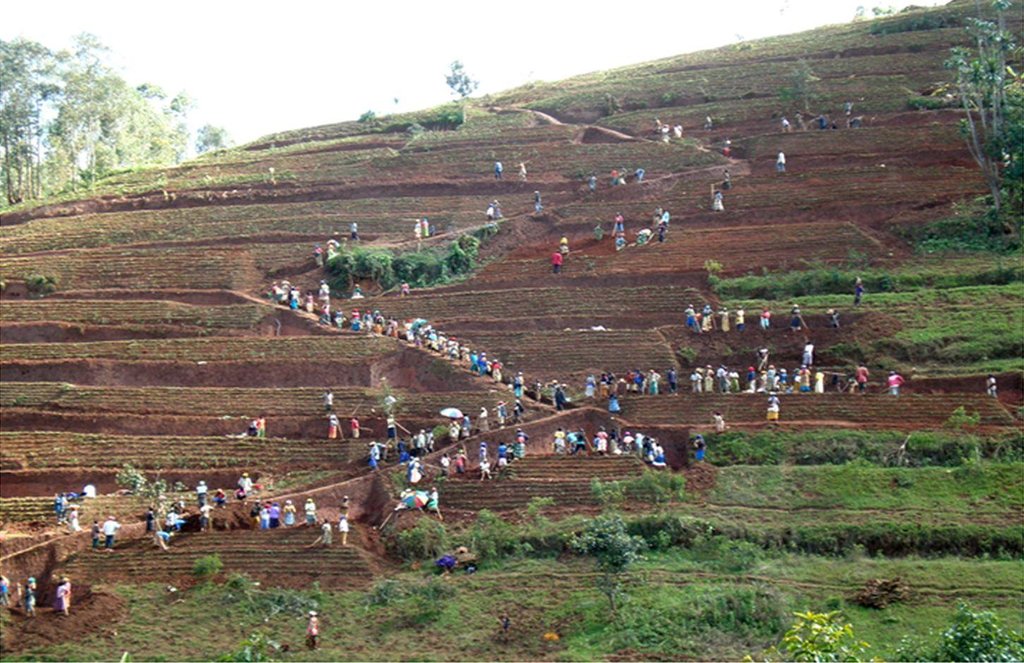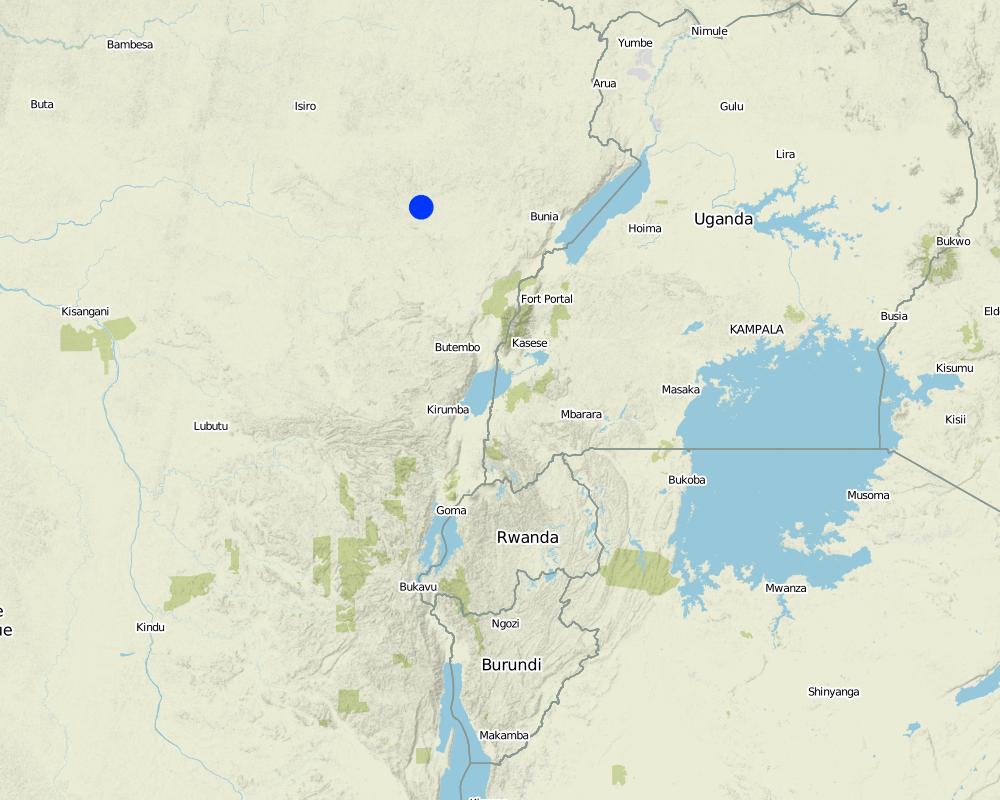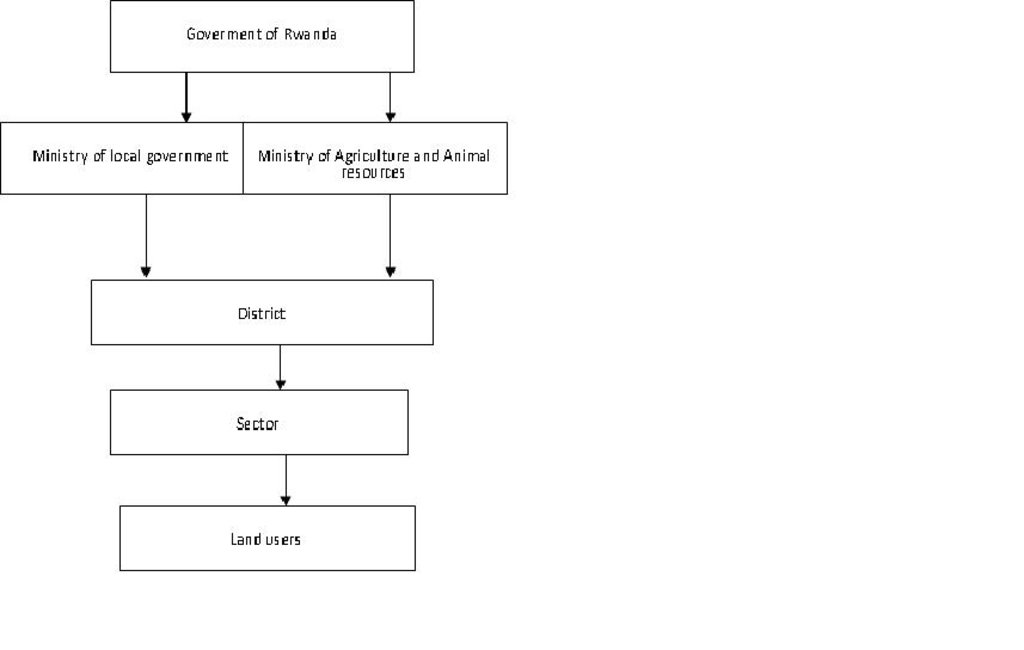Top down approach [Руанда]
- Шинийг нээх:
- Шинэчлэх:
- Эмхэтгэгч: Desire Kagabo
- Хянан тохиолдуулагч: –
- Хянагч: David Streiff
Amabwiriza aturutse ibukuru
approaches_2465 - Руанда
Бүлгүүдийг үзэх
Бүгдийг дэлгэх Бүгдийг хаах1. Ерөнхий мэдээлэл
1.2 Арга барилыг баримтжуулах болон үнэлгээ хийхэд оролцсон хүн эсвэл байгууллагын холбоо барих хаяг
ГТМ мэргэжилтэн:
Арга барилыг баримтжуулах/үнэлэх ажилд дэмжлэг үзүүлсэн төслийн нэр (шаардлагатай бол)
The Transboundary Agro-ecosystem Management Project for the Kagera River Basin (GEF-FAO / Kagera TAMP )1.3 WOCAT-аар баримтжуулсан өгөгдлийг ашиглахтай холбоотой нөхцөл
Мэдээллийг хэзээ (газар дээр нь) цуглуулсан бэ?
01/01/2011
Эмхэтгэгч болон гол мэдээлэгч хүн(хүмүүс) WOCAT аргачлалаар баримтжуулсан мэдээллийг ашиглахтай холбоотой нөхцлийг хүлээн зөвшөөрсөн:
Тийм
1.4 ГТМ-ийн технологийн асуулгын(д) суурь мэдээлэл(д)
2. ГТМ Арга барилын тодорхойлолт
2.1 Арга барилын товч тодорхойлолт
This is a top down approach to technology development and dissemination with limited involvement of intended beneficiaries.
2.2 Арга барилын дэлгэрэнгүй тодорхойлолт
Арга барилын дэлгэрэнгүй тодорхойлолт:
Aims / objectives: The objective of the top down approach is to assign the state a crucial role to drive a designed rural development and land management master plan that needs people to implement it.
To bring farmers together to address an identified problem such as to improve the socio economic situation of rural areas, to prevent , to conserve and to rehabilitate on-site damages caused by land degradation and erosion.
Methods: The top down approach here refers to the level of farmer participation in relation to shared decision making when establishing bench terraces/soil conservation practices in Rwanda. The focus being particularly on the role of farmers in the decision making process during two major phases of the process of terrace construction including: (1) when and where to construct bench terraces in communities and the criteria for site and beneficiary selection. The level of farmer participation and decision sharing have the potential of in increasing the ownership of the of the existing or future bench terraces, hence to ensure its sustainability. Recent studies assert that most of the terraces that are constructed are supply driven and that farmers do not participate in the decisions regarding where and when to construct them. When farmers do participate, it is mostly only through some consultation and their own efforts to mobilize collective labor for the construction of the terraces.
Stages of implementation: Stage one comprises the analysis of current or initial adoption decisions of soil conservation practices, while stage two assesses farmers’ ability to continue the use of these practices. Stage three analyses future adoption proxied by farmers’ willingness to uptake more soil conservation practices.
Role of stakeholders: The state plays a prime role in bench terraces development and the role of other stakeholders (e.g. extension agents, farmer associations) is marginal. Farmer associations involvement is is limited to mobilizing labor and, sometimes, to identifying land for terracing. Extension agencies/services are involved in providing advice to individual farmers or farmers grouped in cooperatives. Community representatives, whom are members of the farmers’ cooperatives themselves, are trained to provide additional support and advice to farmers.
Other important information: This SLM approach argues for a role of the state with top-down and coercive measures in the development of soil conservation practices, particularly bench terraces. Currently there is a two pronged approach based on the realization that bench terraces are ready made constructions which require substantial financial and institutional investments. Mustering labor and resources for the construction and maintenance of bench terraces remains a key aspect of the state’s conservation drive. State-farmer relationships, therefore, continue to be essential to soil conservation efforts in Rwanda and to bench terrace construction in particular.
2.3 Арга барилын зурагууд
2.5 Арга барил нэвтрүүлсэн улс орон / бүс нутаг / байршил
Улс:
Руанда
Улс/аймаг/сум:
East
Байршлын дэлгэрэнгүй тодорхойлолт:
Kayonza
Тайлбар:
The area is not well known, it is approximately estimated
Map
×2.6 Арга барилыг эхлэх, дуусах огноо
Эхлэх жилийг тэмдэглэ:
1950
2.7 Арга барилын төрөл
- government based
2.8 Арга барилын үндсэн зорилго, зорилтууд
The Approach focused mainly on SLM with other activities (Increase soil fertility, good practices of land management in general)
To raise awareness to land users for a particular problem and involve them to get to the right solution
The SLM Approach addressed the following problems: low agricultural production due to a poor agriculture practice and lack of technical knowledge by farmers
2.9 Арга барилын хүрээнд хэрэгжсэн Технологи/Технологиудад дэмжсэн эсвэл саад учруулсан нөхцлүүд
санхүүгийн нөөц, үйлчилгээний хүртээмж / боломж
- Хазаарлалт
terraces and trenches require high investment for establishment and maintenance.
Treatment through the SLM Approach: the government support and other local and Internationale NGOs is highly required
Хууль, эрхзүйн хүрээ (газар эзэмшил, газар, ус ашиглах эрх)
- Идэвхижүүлэх
- Хазаарлалт
ГТМ-ийн талаарх мэдлэг, техникийн дэмжлэг авах боломж
- Хазаарлалт
lack of technical knowledge and cohesion between farmers to address the main problem regarding agriculture in their location.
Treatment through the SLM Approach: implementation of agricultural cooperative
3. Оролцогч талуудын оролцоо ба үүргүүд
3.1 Арга барилд оролцогч талууд болон тэдгээрийн үүргүүд
- Орон нутгийн газар ашиглагч / орон нутгийн иргэд
Farmers
There were no limitation all farmers were involved
- ГТМ-ийн мэргэжилтэн/ хөдөө аж ахуйн зөвлөх
- Судлаачид
- Орон нутгийн захиргаа
Local leaders
- Засгийн газар (шийдвэр гаргагч, төлөвлөгч)
Parliament
3.2 Арга барилын янз бүрийн үе шатанд орон нутгийн газар ашиглагчид / бүлэглэлүүдийг татан оролцуулах
| Орон нутгийн газар ашиглагч / орон нутгийн иргэдийн оролцоо | Хэн оролцсоныг тодорхойлж, үйл ажиллагааг тайлбарлана уу | |
|---|---|---|
| санаачлага/идэвхжүүлэлт | үгүй | |
| Төлөвлөгөө | үгүй | |
| Хэрэгжилт | интерактив | Land users and local authorities work together to get to greater result. |
| Мониторинг/ үнэлгээ | интерактив | Land users are in daily interaction with Sector Agronomist who is in charge of all agricultural activities in the sector. |
| Research | үгүй |
3.3 Диаграм (хэрэв боломжтой бол)
Тодорхойлолт:
chart showing stages of top down approach.
Зохиогч:
Kagabo Desire and Ngenzi Guy (RAB)
3.4 ГТМ-ийн технологи/технологиуд сонгох шийдвэр
Хэрэгжүүлэх Технологи/Технологиудын сонголтыг хийж шийдвэр гаргасан хүнийг тодорхойлно уу:
- ГТМ-ийн мэргэжилтэн дангаараа
Тайлбар:
Decisions were made in the ministry of agriculture after consultation of researchers.
Decisions on the method of implementing the SLM Technology were made by by politicians / leaders. Politicians have decided the way of implementation through community work known as UMUGANDA
4. Техникийн дэмжлэг, чадавхи бүрдүүлэх, мэдлэгийн менежмент
4.1 Чадавхи бэхжүүлэх/сургалт
Газар эзэмшигчид / бусад оролцогч талуудад сургалт явуулсан уу?
Үгүй
4.2 Зөвлөх үйлчилгээ
Газар ашиглагчдад зөвлөх үйлчилгээ авах боломжтой байдаг уу?
Тийм
Тодорхойлолт / тайлбар:
Advisory service is quite adequate to ensure the continuation of land conservation activities
4.3 Институцийг бэхжүүлэх (байгууллагын хөгжил)
Арга барилаар дамжуулан институц байгуулагдаж эсвэл бэхжсэн үү?
- Тийм, дунд зэрэг
Байгууллагууд бэхжиж, үүсэн бий болсон түвшин(үүд)-г тодорхойлно уу:
- Орон нутгийн
Дэмжлэгийн төрлийг ялга:
- Санхүүгийн
- чадавхи бэхжүүлэх / сургалт
4.4 Мониторинг ба үнэлгээ
Мониторинг болон үнэлгээ нь арга барилын хэсэг үү?
Тийм
Тайлбар:
bio-physical aspects were ad hoc monitored by government through observations; indicators: local leadres
bio-physical aspects were regular monitored by project staff, government through measurements; indicators: local agronomist
technical aspects were regular monitored by government through observations; indicators: local agronomist
technical aspects were regular monitored by government through measurements; indicators: local agronomist
socio-cultural aspects were None monitored by government through observations; indicators: local leaders
area treated aspects were None monitored by government through observations; indicators: local agronomist
area treated aspects were None monitored by government through measurements; indicators: all person of 18 years and above are involved
no. of land users involved aspects were None monitored by government through observations; indicators: None
no. of land users involved aspects were None monitored by government through measurements; indicators: None
management of Approach aspects were None monitored by government through observations; indicators: None
There were no changes in the Approach as a result of monitoring and evaluation: None
There were no changes in the Technology as a result of monitoring and evaluation: None
4.5 Судалгаа
Судалгаа арга барилын хэсэг нь байсан уу?
Үгүй
5. Санхүүгийн болон гадаад материаллаг дэмжлэг
5.1 ГТМ-ийн Арга барилын бүрэлдэхүүн хэсгийн жилийн төсөв
Хэрэв жилийн төсөв тодорхойгүй бол хягаарыг тодруулна уу:
- 100,000-1,000,000
Тайлбар (жнь: санхүүжилтийн гол эх үүсвэр / гол хандивлагчид):
Approach costs were met by the following donors: government (planing): 20.0%; local government (district, county, municipality, village etc) (sensitization and follow up): 25.0%; local community / land user(s) (implimentation): 55.0%
5.2 Газар ашиглагчдад санхүүгийн / материаллаг дэмжлэг үзүүлсэн
Технологи / технологийг хэрэгжүүлэхэд газар ашиглагчид санхүүгийн / материаллаг дэмжлэг авсан уу?
Тийм
Хэрэв тийм бол дэмжлэгийн төрөл(үүд), нөхцөл, болон нийлүүлэгч(чид) бичнэ үү:
inputs (seeds, fertilizers, etc..) provided by the Government
5.3 Тодорхой зардлыг даахад чиглэсэн дэмжлэгт (хөдөлмөрийн хүчийг оролцуулаад)
- Хөдөө аж ахуй
| Ямар хөрөнгө оруулалт татаасаар олгогдсоныг заана уу | Ямар талбайн хэмжээнд | Тэтгэмж, урамшууллыг тодорхойлно уу |
|---|---|---|
| Үр, үрсэлгээ | Бүрэн санхүүждэг | |
- Барилга байгууламж
| Ямар хөрөнгө оруулалт татаасаар олгогдсоныг заана уу | Ямар талбайн хэмжээнд | Тэтгэмж, урамшууллыг тодорхойлно уу |
|---|---|---|
| material | хэсэгчлэн санхүүждэг | |
Хэрэв газар ашиглагчийн хөдөлмөрийн хүч чухал байсан бол энэ нь аль хэлбэр байсан:
- сайн дурын
Тайлбар:
After the sensitization by local leaders, activities are done voluntarily or with food-for-work by farmers.
5.4 Кредит
Арга барилын хүрээнд ГТМ-ийн үйл ажиллагаанд зориулж зээлд хамрагдсан уу?
Үгүй
6. Нөлөөллийн дүн шинжилгээ ба дүгнэлт
6.1 Арга барилын нөлөөллүүд
Арга барил нь ГТМ-ийн технологийг хэрэгжүүлж, хадгалахад газар ашиглагчдад тусласан уу?
- Үгүй
- Тийм, бага зэрэг
- Тийм, зарим
- Тийм, их
the approach helped in the implementation of technologies which improved crop production and soil conservation.
Did other land users / projects adopt the Approach?
- Үгүй
- Тийм, бага зэрэг
- Тийм, зарим
- Тийм, их
some project introduced new technology (e.g. one cow per family) with the help of local leaders
Did the Approach help to alleviate poverty?
- Үгүй
- Тийм, бага зэрэг
- Тийм, зарим
- Тийм, их
as the production increase, it increases as well the well being of farmers
6.2 ГТМ-ийг хэрэгжүүлэх газар ашиглагчидын гол санаачилга
- үйлдвэрлэл нэмэгдсэн
improve soil quality and crop production
- Ашиг нэмэгдсэн (боломж), зардал-үр ашгийн харьцаа сайжирсан
as production increases this allows farmers to take a part of the production on market
- төлбөр / татаас
low cost of inputs as they are provided by the government
- well-being and livelihoods improvement
as production and income increases, its facilitates farmers to access to all sanitary services, etc.
6.3 Арга барилын үйл ажиллагааны тогтвортой байдал
Газар ашиглагчид арга барилаар дамжуулан хэрэгжүүлсэн арга хэмжээг тогтвортой хадгалж чадах уу (гадны дэмжлэггүйгээр)?
- Тодорхойгүй
Хэрэв үгүй эсвэл тодорхойгүй бол дэлгэрэнгүй тайлбар өгнө үү:
It require a strong follow up
6.4 Арга барилын тогтвортой/давуу тал/боломжууд
| Газар ашиглагчдын тодорхойлсон давуу тал/боломжууд |
|---|
| It help farmers to work together for a common issue. (How to sustain/ enhance this strength: continuous sensitization ) |
| Эмхэтгэгч, бусад мэдээлэл өгсөн хүмүүсийн өнцгөөс тодорхойлсон давуу тал/боломжууд |
|---|
| Improvement of livelihoods (How to sustain/ enhance this strength: continuous sensitization) |
| farmers are getting benefits, as it has a direct impact in increasing the soil productivity and improve workability of the land (How to sustain/ enhance this strength: continuous sensitization ) |
| the approach helped to establish SLM measures which reduced soil erosion and improve soil quality (How to sustain/ enhance this strength: continuous sensitization) |
6.5 Арга барилын дутагдалтай/сул тал/аюул болон тэдгээрийн хэрхэн даван туулах арга замууд
| Газар ашиглагч нарын тодорхойлсон сул тал/ дутагдал/ эрсдэл | Тэдгээрийг хэрхэн даван туулах вэ? |
|---|---|
| lack of strong link in the farmers association and cooperatives | continuous sensitization |
| Эмхэтгэгч, бусад мэдээлэл өгсөн хүмүүсийн өнцгөөс тодорхойлсон сул тал/ дутагдал/ эрсдэл | Тэдгээрийг хэрхэн даван туулах вэ? |
|---|---|
| High costs: farmers depend on external support from the government, they are not willing to invest their labour without payments. | To make the working time as short as possible for the community work so that farmer can plan other income activities after this. |
| lack of land users participation in the design and planing | involve all stakeholders |
7. Суурь мэдээлэл болон холбоосууд
7.1 Мэдээллийн эх үүсвэр/аргууд
- Хээрийн уулзалт, судалгаа
- Газар ашиглагчтай хийсэн ярилцлага
Холбоос ба модулууд
Бүгдийг дэлгэх Бүгдийг хаахХолбоосууд
Холбоос байхгүй байна
Модулууд
Модуль байхгүй байна


